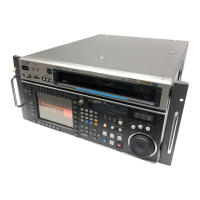
 Loading...
Loading...
Do you have a question about the Sony 5500 and is the answer not in the manual?
Highlights the core capabilities and technological advantages of the SRW-5000/SRW-5500 recorders.
Explains the different menu screens (HOME, TC, VIDEO, AUDIO, CUE, PF, SET UP) and their functions.
Illustrates typical HD digital and NTSC/PAL connection configurations for playback and recording.
Illustrates typical HD digital connection configurations for playback and recording.
Shows how to connect for NTSC/PAL digital signals, including connecting to other VTRs.
Covers menu configuration, item registration, VTR memory banks, and memory stick operations.
Details the process of assigning frequently used items to function buttons.
Describes how to store up to eight sets of menu settings in VTR memory banks.
Covers formatting, saving, and recalling data to and from a memory stick.
Explains how to save and recall factory default values for menu items.
Details saving and recalling default settings to and from a memory stick.
Function to disable recording, with options for different areas.
Covers selection between assemble and insert edit modes.
Allows selection, reset, setting, and holding of time data types.
Instructions for setting cue points directly or via numeric input.
Choosing the signal source for VTR servo synchronization.
Adjusting various video parameters like levels, gain, phase, and black/setup levels.
Configuring audio input sources for channels 1-12.
Assigning audio tracks for digital output channels.
Assigning audio tracks for analog output channels CH1-CH4.
Assigning audio tracks for SD SDI digital output.
Accesses the comprehensive menu for VTR operating conditions and settings.
Outlines initial switch and menu settings required before starting recording.
Details how to select audio input signals and channels for input and monitoring.
Procedure for setting and adjusting audio recording levels for each channel.
Provides step-by-step instructions for performing a recording operation.
Step-by-step instructions for performing a recording operation.
Procedure for setting and adjusting audio playback levels for monitoring.
Covers various playback modes including normal, variable, and DMC.
Covers automatic editing modes, setting points, and basic editing procedures.
Introduces assemble and insert modes for automatic video editing.
Instructions for setting IN and OUT points for video and audio.
Procedures for deleting or moving edit points by one frame unit.
Steps to execute automatic editing once edit points are set.
How to adjust edit points after automatic editing has been performed.
Covers advanced editing techniques like DMC, animation, and preread editing.
Performing variable speed editing using Dynamic Tracking.
Provides a step-by-step guide for performing manual editing operations.
Step-by-step guide for performing manual editing operations.
Lists and explains error messages, protection mode, and warning messages.
Describes messages indicating malfunctions or internal system errors.
Lists and explains various warning messages that may appear during operation.